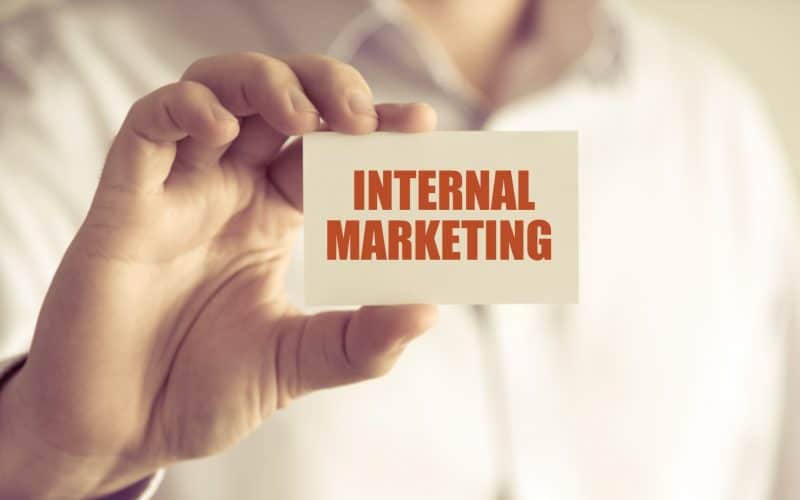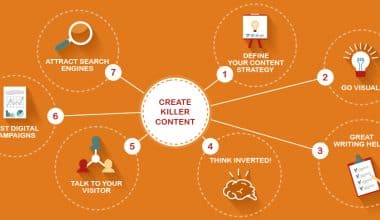Internal marketing, when followed effectively, ensures that your employees are providing high-quality service to your customers and helping the company grow. One of the key components of internal marketing is to have effective internal communication in place. Moreover, we’ll be discussing internal marketing strategies, ideas, tools, and examples. Therefore, investing in internal marketing ensures your employees are working in line with your company’s goals, vision, mission, and objectives. To serve your customers in the best possible way and the general growth of the business.
Briefly, internal marketing is the promotion of a company’s vision, goals, culture, and mission statement within the organization. Internal marketing also helps the promotion of a company’s objectives, products, and services to employees within the organization. The purpose is to increase employee engagement with the company’s goals and foster brand advocacy.
What Are the Types of Internal Marketing?
- Social media accounts, the organization’s website, and other online endeavors.
- Promotional and employment possibilities.
- The company’s rewards, incentives, and programs for work-life balance.
- Sessions of training, education, and growth.
What Is Internal Marketing Objectives?
Internal marketing’s primary purpose is to engage, educate, and motivate workers so that they may thrive in their positions. Internal marketing enables you to empower your teams and boost business outcomes concurrently by promoting employee engagement and effective communication.
Internal Marketing Strategies
So many companies don’t realize that it’s your internal marketing strategies that really determine the progress of your business. Regardless of how powerful your external marketing strategy may be. As a result, you should be able to look at strategic questions like, what’s our team’s mission? What is our vision? What type of culture do we want to have? How are we communicating? What training and development programs do we have in place? How are we ‘listening’ to our people? And so on. Below are great internal marketing strategies that work like a charm:
1. Brand education
Brand education means simply helping your employees understand your company’s history and mission. This is also an important component of your internal marketing strategy. It’s also an important step in building an inclusive company culture. By making your employees feel like they are a part of something bigger, they may be more likely to participate in brand advocacy.
However, this might include presentations, videos, or graphics explaining how the company has grown and progressed since its inception. These efforts may also include giving away freebies like branded sweatshirts, water bottles, and similar products. Even if employees in your company don’t wear uniforms, these gifts can help them feel more like a member of the team.
Moreover, brand education can help employees to stay up to date with the current information about your brand.
2. Create Employee recognition programs
An effective employee recognition program can be the central pillar of an internal marketing strategy. This is especially true for smaller organizations with fewer employees. Also, recognition helps team members know that management sees and appreciates their hard work.
3. Integrated communication apps
Employee communication is a key and communication apps can make it easy to get information faster to your employees. Internal marketing campaigns can use this technology to deliver branded information and keep everyone in alignment with broader company objectives. For example, you could use apps to announce new product or service rollouts.
In addition, apps can offer powerful ways to measure engagement. You can easily see who has adopted the app and who uses it most frequently. This data can show you which employees are your best brand advocates. You can also strengthen app usage reports to support future internal marketing.
4. Employee roundtables
Employee roundtables can offer employees a safe and constructive place to get together with management and share their ideas. Roundtable discussions should allow individuals to disagree with one another while remaining civil and respectful.
Insights obtained from the discussions can inform new HR initiatives and support the marketing team in understanding what employees like or dislike about the company. Transparency is key. Managers should also minimize their own interactions and focus on listening to what their employees have to say.
5. Bonding activities
Your internal marketing plan should include activities focused entirely on helping your employees feel like they’re part of the team. In other words, not every activity should be about promoting your brand to your employees. Sometimes, people just need to sit back and have some fun.
Taking your team out to lunch is a fun way for employees to get to know one another in an informal setting. By increasing employee comfort levels, it becomes easier for team members to share ideas, ask questions and even drive innovation. This is also an internal marketing examples.
Further, here are more internal marketing ideas:
- Identify every area where the organization comes into contact with the marketplace.
- Allow top performers to provide feedback on internal marketing and HR issues.
- Use newsletters or in-house radio programs to spread information and reinforce organizational culture.
- Make the marketing strategy a feature of employee training programs.
- Provide access to information as frequently as possible.
- Create performance-based incentives.
- Provide comprehensive and ongoing training programs for employees at every level.
- Position the brand as part of a narrative that employees can relate to and participate in.
- Use technological tools like blogs, message boards, and wikis to spread information.
- Tailor internal marketing messages to each department. Messages to salespeople will be different than messages aimed at IT staff.
- Highlight success like new contracts awarded or sales targets met.
- Encourage collaboration between departments.
Internal Marketing Tools
Some of the most effective internal marketing tools include the following:
#1. Training
Frequent training programs are vital internal marketing tools. Where employees in their teams engage in shared learning experiences. This tends to build social support networks among themselves that further the internal marketing goal of employee engagement with the organization, as well as increase job satisfaction.
#2. Communicate regularly
Placing the organizational objective with the employee’s attitude is another relevant step in the internal marketing process. You should always keep your employees informed about your goals and should clearly give full insight into the purpose for which your business is in the market. Convey the message to the employees that “this is the purpose for which we are in the market”. We should then take necessary steps so that the employees can harmonize their attitude or behavior.
#3. Events
Regular Uplifting events that get employees in a positive mood is another valuable internal marketing tool. Such events serve the dual purpose of rewarding employees and elevating the image of the brand in the eyes of each staff member. This can also serve as a great internal marketing example.
#4. Introducing core values
Make use of every possible marketing platform to introduce the core values of your business. Core values are the structures and foundation of your business, above all, it directs decision making and acts as guidance for all actions and behavior within the business. It is critical that all staff members take full ownership of your core values.
#5. Empowering employees
When the employees feel that they are authorized and empowered to make a decision, they can show their natural creativity which eventually will help satisfy the customers. This authorization and empowerment also entail the accountability of the employees.
Create regular employee newsletters that provide employees with information about the current projects, growth and initiatives of the company. Newsletters should educate team members on new products, services or customers, equip them with the information they need to best do their jobs and remind them of the expectations and goals of the company.
#7. Clear job specifications
Clear job specifications entail that employees should know what to do; when to do it; how to do it; for whom to do it, to facilitate achievable organizational objectives. Any lack of coordination directly equals the lack of internal marketing. So, coordination must be established.
#8. Pleasant working environment
Creating a corporate culture in which every employee can share their views with others. The safety and well-being of your teams should be one of the top priorities of the company. With a commitment to providing an exclusive work environment. One that encourages respect for social diversity, based on the safety and the personal fulfillment of each employee.
#9. Department competitions
Try Creating a healthy competitive environment that inspires teamwork among members of a particular department. Contests or competitions between departments break up the regular routine of the workday, build friendships and provide the opportunity for members of departments who may not be familiar with each other to interact.
All internal marketing tools listed are very important to help your employee. So, it’s advisable for employers/ executives to uniquely employ these tools for the good of the company. Meanwhile, you can also read the internal marketing examples below.
What Is External Marketing?
When a company does market research and advertising aimed at attracting new customers, they are engaging in what is known as “external marketing.”
What Is Internal Marketing and External Marketing?
The difference between internal and external marketing is that your internal marketing audience is made up of people you already know. Instead of trying to make new connections, internal marketing builds on the relationships you already have and tries to make them stronger. Other goals are also different.
Internal Marketing Examples
Let’s go through a few internal marketing examples you can apply:
#1. Consistent communication of the Company’s Mission, Vision, & Values.
#2. Get a strong 1-2 year internal marketing Plan.
#3. Seeking & acting on employee feedback.
#4. Clear, centralized internal communication
#6. Better learning & development
#7. Provide the benefits employees want
#8. Create more frequent promotion cycles
#9. Celebrating new business deals and major milestones
#10. Monthly employee spotlights
#11. Company-wide brainstorming for new products/services
#12. Creating and sharing the company’s “origin story”
#13. Process improvement workshops between departments
#14. Reorganized / improved office layout
#15. Free company swag/gear
#16. Performance-based incentives
#17. Interdepartmental rotational programs
Examples Of Common Internal Marketing Strategies
Using internal marketing strategies to improve your customers experience as well as increases company sales. Examples of common internal marketing strategies include:
Inbound marketing is essentially about enticing customers with engaging or instructional material that adds value at every stage of the customer’s purchasing experience. Blogs, search engines, and social media are typical ways for potential clients to find you.
Outbound Marketing: This is a more conventional style of marketing in which a firm actively pushes messaging to their target demographic. Outbound marketing relies heavily on traditional marketing and advertising formats such as TV commercials, radio ads, print advertisements, trade fairs, outbound sales calls (cold calling), and so on.
Read Also: Business Communication: How to Develop an Effective Communication Strategy
Conversational Marketing: A more interactive kind of marketing, this is a technique that, as the name implies, initiates a dialogue with your target audience. This typically takes the shape of a chatbot (such as the one that appeared when you first visited our site), live chat with a real person, voice assistants, and so on. The cool thing about conversational marketing is that you can customize the discussion to each user by customizing how a bot, for example, responds to a specific input.
These are only a few alternatives, all of which can contribute significantly to the success of your marketing approach. You could also use influencer marketing, affiliate marketing, or external marketing, depending on your business, but I’ll let you look into those on your own.
What Is Internal Marketing Environment?
Internal marketing environments are made up of variables that are under your control and have an influence on your marketing operations, such as your organization’s strengths, weaknesses, distinctiveness, and capabilities.
Internal Marketing Ideas
The idea behind internal marketing is to earn employees’ enthusiasm by creating an emotional connection to the brand. Let’s discuss some internal marketing ideas:
Encourage Team Spirit
Try to create a bond as a team. What’s that thing that encourages your team and also keeps the team spirit alive? whatever it is for your company, mix it up and do it often. Make sure your team bonds and each member appreciates the other’s point of view and personality. This is a vital idea among all the internal marketing ideas.
Create an Understanding Culture
Someone has just broken up with their long-term girlfriend, so we give him some slack while he comes to terms with his breakup. That is the norm. If someone is having a bad day be it personal or family issues. It could affect that person’s work for the day we should try to understand and help this person cheer up. Maybe give them an off day, or we buy them coffee or chocolate. It’s the little things that matter the most.
Throw Perfection out the Door
No one is perfect. Let that sink down that… no-one is perfect. So get over trying to be perfect or expecting your team or company to be perfect. Humans are not robots. They will make mistakes. Make that ok. As long as they learn from mistakes then that is all that matters. Put a “Fail Fast” system in place – and it will change your culture overnight.
Teach Your Team to Love the Feeling of Wining
Who doesn’t like to win? How great does winning feel? When a marketing consultant wins a new account or scores a happy client through developing a marketing idea that has achieved great results, they lift. Actually, everyone lifts. The feeling of winning cannot be replaced but needs to be remembered in order to desire that feeling again. Make sure you savor the winning moments and remind people of just how good it felt. However, these internal marketing ideas could be just what you need to achieve success with your team. So, don’t take it for granted.
Most effective Internal marketing strategies
Once a workplace culture has been thoroughly established and some basic social media education or training has been completed, your organization must trust individuals to actively discuss the brand online – wherever that may be.
Encourage your staff to share on social media! It improves relationships with current customers, and the important insights your staff give might persuade prospects to trust the company more in general.
Maintain employee engagement. Employees who believe in the brand and are trusted to be its human voice naturally become brand ambassadors who can vouch for the firm and its product on and off the job. As a result, combining them with a good internal marketing plan can significantly boost your internet presence, lead quality, and traffic to the company website.
Frequently Asked Questions
What is meant by internal marketing?
Internal marketing is the promotion of a company’s goals, goods, and services to its internal personnel. The idea is to encourage staff involvement in the company’s goals while also encouraging brand advocacy. It’s also crucial to keep employees pleased and engaged when it comes to internal or external marketing.
What are the characteristics of internal marketing?
Highly effective internal marketing initiatives include six characteristics
- senior management participation,
- integrated organizational structure,
- strategic marketing strategy,
- human resources cooperation,
- focus on employee engagement
- internal brand communication.
Why is internal marketing important?
Internal marketing assists businesses in providing better customer service. Employees are more motivated and satisfied with their jobs. They are given the authority to make judgments within specific parameters, and they begin to feel more appreciated and valued for their contributions.
- BUSINESS PLAN: Examples and Template for Startup
- MARKETING DEPARTMENT: Overview, structure, roles, expectations (+free tips)
- People Management: Top Skills for Managers(+Book Picks).
- Marketing Environment: Definition, Concept & Best Practices (+ Case Studies)
- MARKETING INFORMATION SYSTEM: A Detailed Guide
- Control Accounting: Definition, And All You Need






